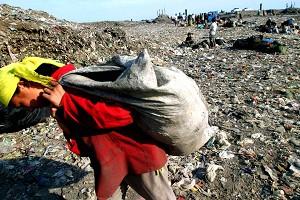The January 4 issue of The Beijing News mentions the story of two sisters from a poor family in Fusong County, Jilin Province who cannot afford to eat at school. The older sister Li Xiaoni is a sophomore in high school, and the younger sister Li Mei is in middle school. The two sisters always return home from school with 160 pancakes made by their mother, which counts as their food for roughly a month. The older sister said they dared not eat from the school cafeteria because each meal costs at least one yuan ($0.12). Their parents already have a hard time paying their tuition.
The plight of these two sisters is not rare in rural China. In China today, all families with children in school carry a heavy burden. Besides tuition and book fees, there are additional various school fees for elementary and middle schools, such as fees for make-up classes, sponsorship, reviews, funding, etc. In 2003, elementary and middle schools became the second most profitable industry, after real estate. Some academic experts estimate that from 1993 to 2003, arbitrary collection of school fees has extorted over 200 billion yuan ($24.4 billion) from elementary and middle school students.
Former Vice-Minister of the Chinese Ministry of Education, Zhang Baoqing, was removed from office last year because of his open condemnation on the arbitrary school fees. He pointed out that the major reason for the arbitrary fees in rural compulsory education was that the Chinese communist regime did not allocate the funding properly.
“The government did not accept the funding they should have accepted, as a result, it was subsidized by the ordinary people through arbitrary fee collection,” Zhang said.
The small amount of education funding allocated by the Chinese communist regime, as criticized by United Nation officials, does not even match that of the poor African country, Uganda. Nine-year compulsory education is, at most, a slogan. Many poor rural families and many unemployed urban families cannot afford the tuition, which results in many children dropping out of school. In the middle of December 2005, United Nations Children’s Fund (UNICEF) released a report on The State of the World’s Children 2006, which revealed that, among the 140 million migrant populations in mainland China, approximately 20 million of them are children between the ages of six and fourteen. About nine percent of these children have dropped out of school.
According to statistics by the governmental organizations The China Foundation for Human Rights Development and Project on Helping School with Love, about 1.46 million children of elementary school age drop out of school, whereas 4.97 million children of middle school age drop out of school. The two categories total about 6.4 million children. According to estimates by a scholar in Beijing, the actual number of children dropouts is far more than the statistics provided by the communist regime. Even at least twice as much, approaching 10 million.
Education Commercialized, College Tuition Grew Exponentially
The expense of education, health care, and real estate has already become three mountains that bear down on Chinese people. A survey shows that among the current overall consumer costs, education fees for children have risen to the top position, surpassing the costs for health care and real estate.
Because the Chinese communist regime applies the policy to commercialize college education, tuition has become the major revenue for all colleges. Over the last ten years, college tuition has risen exponentially, increasing over tenfold, far more than the GDP growth rate. According to the Chinese communist regime statistics, per capita income is 9,422 yuan ( $1,140) per year in urban areas, and 2,936 yuan ($358) per year in rural areas. The annual expense for a college student, including tuition and living costs, is on average 7,000 yuan ( $854), making the cost for four years of college at least 280,000 yuan ($34,100). Using this calculation, supporting a college student takes three years of income from an urban resident, and nearly ten years of a farmer’s income.
Zhang Baoqing, the former Vice-Minister of the Chinese Ministry of Education, on multiple occasions, spoke publicly about college school tuition far exceeding the financial capability of an average person. His salary combined with his wife’s salary, he said, could only pay for one child to go to college.
Being Unable to Afford School is One Reason Parents and Students Commit Suicide
According to a report by Hua Shang Bao on December 20, 2004, parents in 1,336 families in Ledu County, Qihai Province had to sell their blood to support their children’s schooling. About 90 percent of parents of students in Machang County’s No. 1 Middle School have relied on long-term blood selling to pay for tuition.
In order to support his son’s college education, Xie Guangfu of Qianqiu Village in Shijiao Town of Qijiang County, Chongqing Province had been working at least 18 hours a day and in the end, died from exhaustion.
Yang Yuxiang, a 53-year old farmer of Xie Jiaying Village in Xinying City of Yuzhong County, Gansu Province was unable to pay for his two children to go to school, so he let the sister and young brother draw lots to decide who would continue school. The sister lost and jumped off a 984-foot-high cliff in desperation. Wang Jingna, a 19-year-old from Fu Jianian Village in Jinniu District of Chengdu City, Sichuan Province was admitted to a college, but she committed suicide by poison on August 14, 2005 because she could not afford the 13,000 yuan ($1585) tuition. A junior college student in Zhangzhou City, Fujian Province committed suicide by ingesting pesticides on March 9, 2005 because he was unable to afford his tuition.
Education Expenses of 1.3 Billion People Less than Regime Officials’ Expenditure on Automobiles
In an article titled “Sending a punitive expedition against the Ministry of Education,” the Chinese scholar Zhou Liang points out that “The number of college students in China has reached 14 million, and the number of graduates has reached 0.9 million, a rate close to that of the U.S. However, the funding allocated by the country is only 70 billion yuan ($8.5 billion), whereas collected fees have reached 40 billion yuan ($4.9 billion); this ratio is rare in the world.”
In September, 2003, when addressing China, a human rights investigator from the UN criticized education funding in China for being one of the least amount in the world, not even matching the poor African country of Uganda. She pointed out that education funding in China only accounts for two percent of GDP, which is only one-third of what the UN suggests. Among these, public funding makes up only 53 percent, whereas almost half of this funding is subsidized by parents or other sources.
According to a report in Hong Kong’s Wen Wei Po , the government officials of the Chinese communist regime have spent up to 300 billion yuan ($36.6 billion) per year on automobile use, which makes up about 38 percent of the overall national financial expense; this number has exceeded the total funding on education and health care.




Friends Read Free